Video: Melbourne & Brisbane March for Australia plus ANTIFA antics and commentary
 The video is 33 minutes long and documents scenes at the Melbourne March for Australia, starting one hour ahead, to give an idea of how things began, then you get an impression, half-way of how the crowds built up to standing-room only, then how they stretched as far as the eye could see.
The video is 33 minutes long and documents scenes at the Melbourne March for Australia, starting one hour ahead, to give an idea of how things began, then you get an impression, half-way of how the crowds built up to standing-room only, then how they stretched as far as the eye could see.

 Climate change poses a real and growing risk to Victoria’s built environment says a report tabled today by the Legislative Council Environment and Planning Committee. Metropolitan Melbourne faces distinct climate change risks due to its high population density and impervious surfaces,intensifying the heat island effect.
Climate change poses a real and growing risk to Victoria’s built environment says a report tabled today by the Legislative Council Environment and Planning Committee. Metropolitan Melbourne faces distinct climate change risks due to its high population density and impervious surfaces,intensifying the heat island effect. The Victorian Government's authoritarian Activity Centres program, heralded, by some, as a means to deliver "more than 300,000 additional homes by 2051," is presented as a progressive response to Melbourne's self-induced housing crisis. However, the reality seems closer to slum construction, ultimately compromising residents' quality of life and democratic rights.
The Victorian Government's authoritarian Activity Centres program, heralded, by some, as a means to deliver "more than 300,000 additional homes by 2051," is presented as a progressive response to Melbourne's self-induced housing crisis. However, the reality seems closer to slum construction, ultimately compromising residents' quality of life and democratic rights. The four former colleagues gathered at a suburban Italian restaurant for one of their regular "catch ups.” But were they really catching up? They had not worked together for about fifteen years but, possibly through habit or email mailing list accident, had still kept in touch. Only one still worked in the same clinical profession that had brought them together.
The four former colleagues gathered at a suburban Italian restaurant for one of their regular "catch ups.” But were they really catching up? They had not worked together for about fifteen years but, possibly through habit or email mailing list accident, had still kept in touch. Only one still worked in the same clinical profession that had brought them together. 


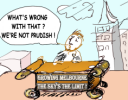 "The Victorian Government has failed to fund 500 housing places for young people living with mental illness almost three years after making the commitment – a key royal commission recommendation." (Council to Homeless Persons, Melbourne City Mission and Orygen) The homelessness press-release says nothing about how massive overseas immigration and investment has driven the excessive demand that has resulted in high prices and housing shortage, but this is the elephant in the room, and t
"The Victorian Government has failed to fund 500 housing places for young people living with mental illness almost three years after making the commitment – a key royal commission recommendation." (Council to Homeless Persons, Melbourne City Mission and Orygen) The homelessness press-release says nothing about how massive overseas immigration and investment has driven the excessive demand that has resulted in high prices and housing shortage, but this is the elephant in the room, and t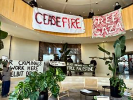 This morning, an alliance of Naarm/Melbourne activists entered the Port Melbourne building of Israeli weapons manufacturer Elbit Systems, with signs reading: ‘ELBIT DRONES KILL KIDS’ 'FREE PALESTINE’ as so-called Australia wakes to the news that another 700 Palestinians being killed overnight by Israeli bombs
This morning, an alliance of Naarm/Melbourne activists entered the Port Melbourne building of Israeli weapons manufacturer Elbit Systems, with signs reading: ‘ELBIT DRONES KILL KIDS’ 'FREE PALESTINE’ as so-called Australia wakes to the news that another 700 Palestinians being killed overnight by Israeli bombs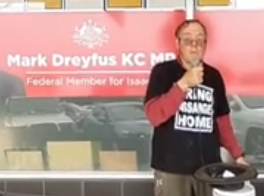 From 10am until 12pm tomorrow, on Thursday 6 April, outside the electoral office of the Attorney General Mark Dreyfus in the south-eastern Melbourne suburb of Mordialloc, supporters of Julian Assange will be protesting to demand that the Australian government act to end the British Government's imprisonment of Julian Assange.
From 10am until 12pm tomorrow, on Thursday 6 April, outside the electoral office of the Attorney General Mark Dreyfus in the south-eastern Melbourne suburb of Mordialloc, supporters of Julian Assange will be protesting to demand that the Australian government act to end the British Government's imprisonment of Julian Assange. Where To From Here - Victorian Local Government Elections 2024; Save Our Canopy Trees – April 1 Forum; Planning and Heritage Inquiry; Level Crossing Removal FOI; VCAT Protest?; Let There Be Light – Brunswick Residents Have a Win; Planning Scheme Amendment St Phillip St Brunswick East; Guest Speaker at Fitzroy Residents Association; John Curtin Hotel; Royal Exhibition Building and Carlton Gardens; Western Port Woodlands Alliance Formed; MAB Attempts to Silence Westmeadows Re
Where To From Here - Victorian Local Government Elections 2024; Save Our Canopy Trees – April 1 Forum; Planning and Heritage Inquiry; Level Crossing Removal FOI; VCAT Protest?; Let There Be Light – Brunswick Residents Have a Win; Planning Scheme Amendment St Phillip St Brunswick East; Guest Speaker at Fitzroy Residents Association; John Curtin Hotel; Royal Exhibition Building and Carlton Gardens; Western Port Woodlands Alliance Formed; MAB Attempts to Silence Westmeadows Re Melbourne State Library 1 pm Saturday 18 March against AUKUS US $170b nuclear sub purchase and alliance
Melbourne State Library 1 pm Saturday 18 March against AUKUS US $170b nuclear sub purchase and alliance 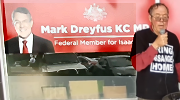 On March 3, 2023, protesters gathered outside Mark Dreyfus, the Australian Attorney General's office, to complain of Dreyfus's failure to object to the British Government's illegal and cruel imprisonment of heroic Australian citizen, Julian Assange. March 3 is Assange's birthday. Inside is the text of James Sinnamon's speech on that occasion.
On March 3, 2023, protesters gathered outside Mark Dreyfus, the Australian Attorney General's office, to complain of Dreyfus's failure to object to the British Government's illegal and cruel imprisonment of heroic Australian citizen, Julian Assange. March 3 is Assange's birthday. Inside is the text of James Sinnamon's speech on that occasion. Contents: Page 1 – Heritage Amendment Bill 2023; Victorian Departmental Restructure; Australian Architecture President Bells the Cat; Legislative Council Planning and Heritage Inquiry; Page 2 – Submissions Closing on World Heritage Management Plan for Royal Exhibition Building and Carlton Gardens; Speech to CROWAG, and April Forum; Level Crossing Removal FOI; War on Plastic – Clean Up Australia Day; Page 3 – South Australia’s Planning Minister Flags Change
Contents: Page 1 – Heritage Amendment Bill 2023; Victorian Departmental Restructure; Australian Architecture President Bells the Cat; Legislative Council Planning and Heritage Inquiry; Page 2 – Submissions Closing on World Heritage Management Plan for Royal Exhibition Building and Carlton Gardens; Speech to CROWAG, and April Forum; Level Crossing Removal FOI; War on Plastic – Clean Up Australia Day; Page 3 – South Australia’s Planning Minister Flags Change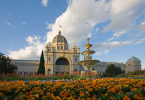 I appreciate the opportunity for public comment on this important issue. I was the Federal Shadow Minister for Environment and Heritage when the then Federal Minister for Environment and Heritage announced the move to nominate the Royal Exhibition Building and Carlton Gardens for World Heritage listing. I have followed the history of this site with considerable interest.
I appreciate the opportunity for public comment on this important issue. I was the Federal Shadow Minister for Environment and Heritage when the then Federal Minister for Environment and Heritage announced the move to nominate the Royal Exhibition Building and Carlton Gardens for World Heritage listing. I have followed the history of this site with considerable interest.
 In this issue:
In this issue:  In this issue: 1.WELCOME TO 2023; 2.VCAT DELAYS; 3.STOP THE GREAT WALL OF FRANKSTON; 4.SUNBURY HIGH RISE TO GO TO VCAT; 5.KILMORE BUSHFIRE EVACUATION ISSUE; 6.BAD NEWS ON THE MORNINGTON PENINSULA; 7. KINGSWOOD GOLF COURSE; 8.477 SYDNEY RD. COBURG – BIKE SPACES, BUT NO CARS PLEASE; 9. PLANNING DEMOCRACY FACEBOOK PAGE; 10. WORLD HERITAGE MANAGEMENT PLAN OVERVIEW; 11.
In this issue: 1.WELCOME TO 2023; 2.VCAT DELAYS; 3.STOP THE GREAT WALL OF FRANKSTON; 4.SUNBURY HIGH RISE TO GO TO VCAT; 5.KILMORE BUSHFIRE EVACUATION ISSUE; 6.BAD NEWS ON THE MORNINGTON PENINSULA; 7. KINGSWOOD GOLF COURSE; 8.477 SYDNEY RD. COBURG – BIKE SPACES, BUT NO CARS PLEASE; 9. PLANNING DEMOCRACY FACEBOOK PAGE; 10. WORLD HERITAGE MANAGEMENT PLAN OVERVIEW; 11.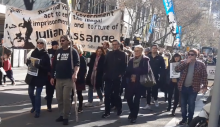 From 4pm, this coming Saturday 11 February, come down to the Victorian State Parliament to celebrate Julian Assange for the
From 4pm, this coming Saturday 11 February, come down to the Victorian State Parliament to celebrate Julian Assange for the 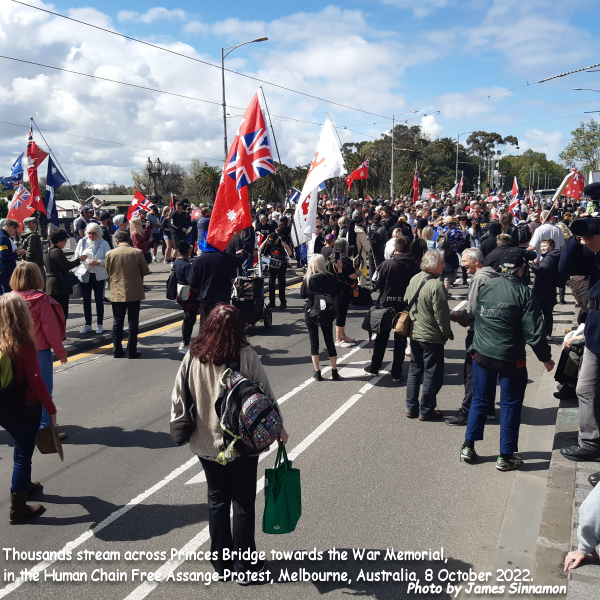 The Human Chain for Assange was attended by more people than we have seen at any Free Assange demonstration in Australia to date. SBS says, "Thousands," Victoria Police estimate 3000.
The Human Chain for Assange was attended by more people than we have seen at any Free Assange demonstration in Australia to date. SBS says, "Thousands," Victoria Police estimate 3000.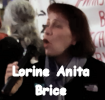 This clear and passionate speech goes to the heart of why it is so vital that we all - especially PM Albanese - stand up for Julian Assange. If we want to be free, we need to free Assange. Lorine (or Anita) is the effective convenor of the Friday Night Flinders St Station Vigil for Julian Assange. She has been doing this for years now, in all weather, and has built up a regular crew of speakers and poster-bearers. She is a real Australian hero.
This clear and passionate speech goes to the heart of why it is so vital that we all - especially PM Albanese - stand up for Julian Assange. If we want to be free, we need to free Assange. Lorine (or Anita) is the effective convenor of the Friday Night Flinders St Station Vigil for Julian Assange. She has been doing this for years now, in all weather, and has built up a regular crew of speakers and poster-bearers. She is a real Australian hero.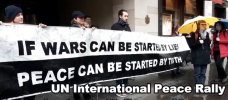 At a protest for Julian Assange, which commenced outside the Victorian State Library at 12:00pm on Sunday 28 September, protestors demanded that the Australian government use the power vested in it as a sovereign national government to make British Prime Minister Liz Truss end the illegal imprisonment and torture of Julian Assange.
At a protest for Julian Assange, which commenced outside the Victorian State Library at 12:00pm on Sunday 28 September, protestors demanded that the Australian government use the power vested in it as a sovereign national government to make British Prime Minister Liz Truss end the illegal imprisonment and torture of Julian Assange.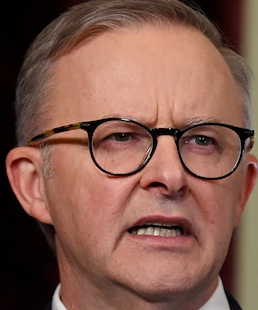 You can help build the protest by printing and distributing the A5 leaflet from which this article was adapted (
You can help build the protest by printing and distributing the A5 leaflet from which this article was adapted (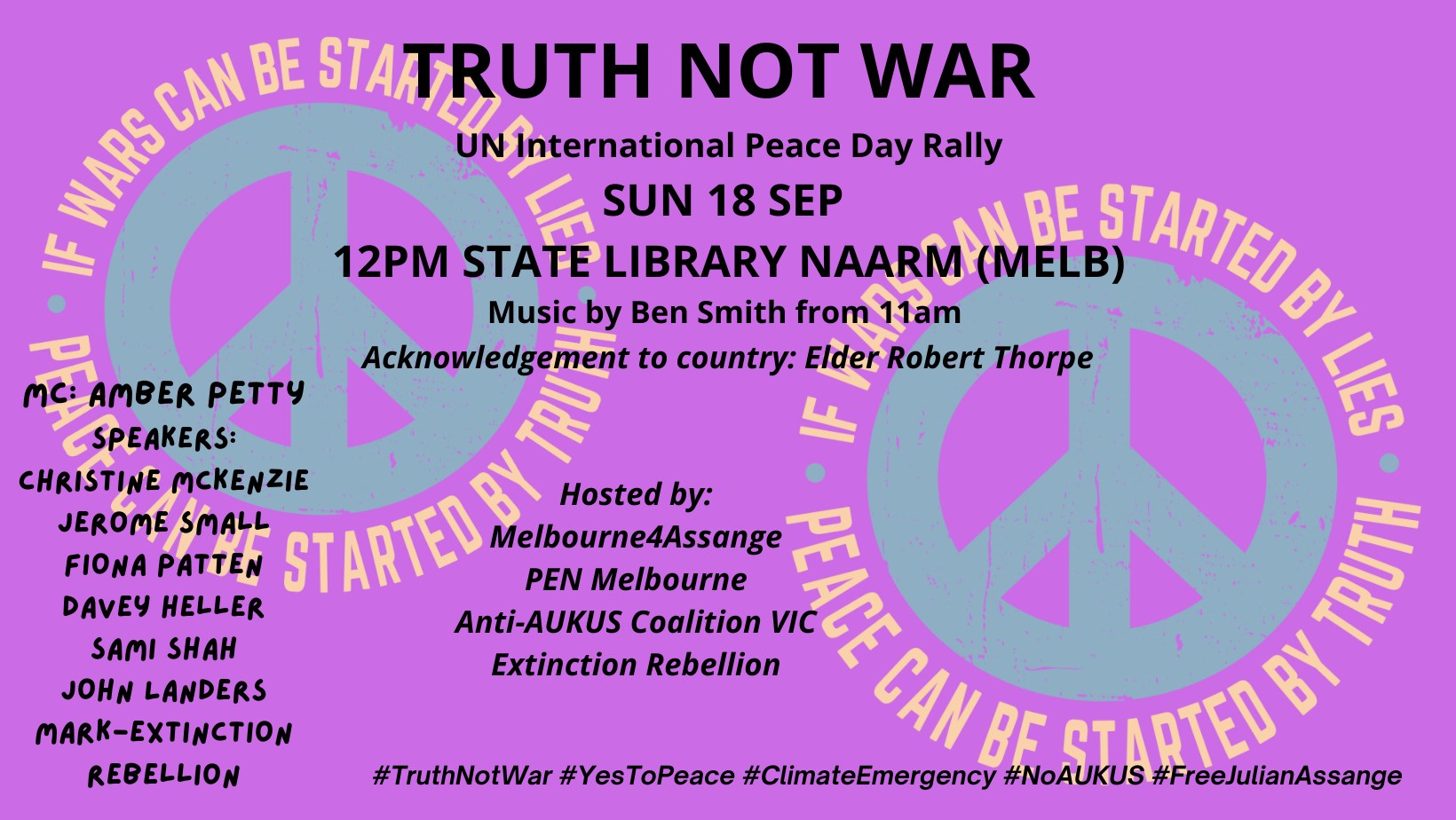
 From 12:30pm today at the Hiroshima Day protest in front of the Victorian State Library in Flinders Street in the Melbourne CBD, John Shipton, Julian Assange's father, will be speaking.
From 12:30pm today at the Hiroshima Day protest in front of the Victorian State Library in Flinders Street in the Melbourne CBD, John Shipton, Julian Assange's father, will be speaking. Meet at Vic State Library for 11am rally and march 3 July 2022, Julian Assange's birthday. Australia's award winning journalist, outstanding publisher, creator of WikiLeaks, and possibly the most famous, heroic, and persecuted person in the world, turns 51 years old. This is his 4th birthday spent locked away in Belmarsh prison, London. His previous 7 birthdays were spent locked away in the Ecuadorian Embassy.
Meet at Vic State Library for 11am rally and march 3 July 2022, Julian Assange's birthday. Australia's award winning journalist, outstanding publisher, creator of WikiLeaks, and possibly the most famous, heroic, and persecuted person in the world, turns 51 years old. This is his 4th birthday spent locked away in Belmarsh prison, London. His previous 7 birthdays were spent locked away in the Ecuadorian Embassy.
 In this issue: Friends of Queen Victoria Market Annual General Meeting; Tree Canopy Cover Forum (Mordialloc); Tree Canopy Cover Whitehorse; Tree Canopy Cover Darebin; VCAT win to protect native grassland; Heritage win at Moonlight Head; Concrete to be removed from Moonee Ponds Creek; Surrey Hills-Mont Albert level crossing removal project; Save Lake Knox update; Beaumaris Modern update; Preserving Mornington Peninsula Open Space; Caulfield Racecourse Update; North East Link
In this issue: Friends of Queen Victoria Market Annual General Meeting; Tree Canopy Cover Forum (Mordialloc); Tree Canopy Cover Whitehorse; Tree Canopy Cover Darebin; VCAT win to protect native grassland; Heritage win at Moonlight Head; Concrete to be removed from Moonee Ponds Creek; Surrey Hills-Mont Albert level crossing removal project; Save Lake Knox update; Beaumaris Modern update; Preserving Mornington Peninsula Open Space; Caulfield Racecourse Update; North East Link
Recent comments